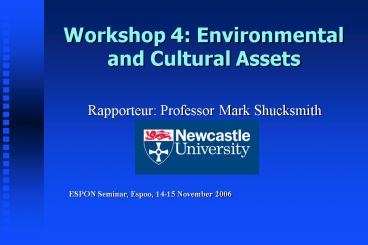Workshop 4: Environmental and Cultural Assets
1 / 9
Title: Workshop 4: Environmental and Cultural Assets
1
Workshop 4 Environmental and Cultural Assets
- Rapporteur Professor Mark Shucksmith
ESPON Seminar, Espoo, 14-15 November 2006
2
Introduction
- Fisheries, environment, culture and tourism are
assets which give places potential to achieve
objectives of competitiveness, cohesion and
sustainability (part of an array of tangible and
intangible assets). - Tension between conservation and exploitation
one challenge is to develop a balanced strategy
how can ESPON help provide the evidence to assist
this? - How to combine tangible and intangible assets?
- How to build the capacity of places to manage
these?
3
Tangible Intangible Assets
- EU FP5 Dynamics of Rural Areas project shows how
tangible and intangible assets can work together.
Tangible resources now less important than
intangibles. - Key to economic performance were
- Institutional and governance structures
- Social capital
- Entrepreneurial spirit (presence of creative
class?) - Education and skills
- Attractive environment
- Cultural resources
4
Fisheries (2.1.5)
- Overexploitation of resource - fleet reductions.
- Growth in aquaculture, but environmental impacts.
- NUTS3 unfit for studying spatial impacts - LAU.
- Spatial planning systems must cover both
terrestrial and marine part of the coastal zone. - Lack of coordination between policies
programmes. - Effectiveness of FIFG programmes depends heavily
on absorptive capacity of regions (governance and
institutional capacity resources alternatives) - Combine best elements of the spatial planning
system with best elements of voluntary
partnership. - ESPON 2013 area studies to unravel causality.
5
Cultural Assets (1.3.3)
- Data difficulties, inconsistent databases
ESPON 2013. - Base indicators heritage assets, landscapes,
museums (commodities) creative class
(productive) cultural diversity, education level
(capacity). - Three classifications developed
- Market comparing visitor numbers with cultural
assets - Functional specialisations how well do regions
pursue conservation production and valorisation
of assets? - Cross Thematic Analysis with other ESPON
measures. - Circular relation between culture and economic
development suggests some strategies shown in
diagram..
6
Low P, high S Under-exploitation of heritage
High P, high S Potential for valorisation of
heritage
Increase demand (higher gear in cultural
marketing)
POTENTIAL DEMAND FOR HERITAGE RESOURCES
Balance
Create alternative cultural products to satisfy
existing demand
Capacity building increase new cultural assets
and use them in regional promotion strategies
Reduce pressure levels (e.g. extreme protection)
Low P, low S Cultural capacity deficit
High P, low S Heritage at risk (excess demand
pressure)
SUPPLY OF HERITAGE RESOURCES
7
Impact of Environmental Policies (2.4.1)
- Territorial trends urban growth unevenly related
to population ? loss of natural semi-natural
areas not correlated with GDP ?. - Can urban growth have positive environmental
impact? - TIA methodology environmental policy -
environment and territorial trends and so -
territorial objectives (eg. Natura 2000
designation reduces mining and quarrying
especially in peripheral areas.) - Studied on different spatial levels local,
regional, national, transnational, and European
level. - Method mainly mapping of two superimposed
variables rather than multivariate analysis.
Causality?
8
Tourism pilot project (1.4.5)
- Trends more, shorter trips urban tourism cheap
flights. - But data only on international travel and
includes business trips. - Future proposed work under ESPON 2013
- Travels and flows
- Who is travelling where, for how long, and why?
What mode? - Economic effects and employment
- Demand side (tourist expenditures and
consumption) - Supply side (accommodation, transportation,
facilities, attractions) - Job creation and economic development
- Environmental and social effects
- Harmonise data to increase comparability
Eurostat data on bed spaces is not only useless
but dangerous. - Address future challenges for tourist regions.
Some case studies - Implications of Stern Report on Climate Change?
9
Discussion
- How does management (and planning) of
environmental and cultural assets affect spatial
development? - Natural Heritage is viewed as an asset for
attracting economic activities does this require
limitations on development? Tension between
enabling and regulatory roles of spatial
planning. - Are there virtuous circles eg. does good scenery
and culture attract creative class who generate
growth? How can this be promoted? - For ESPON 2013 a pilot study is advised focusing
on the use of management and planning tools to
see how intervention might protect, build and
valorise these assets. - Common issue of data deficiencies suggest need
both for data harmonisation and for complementary
approaches.































